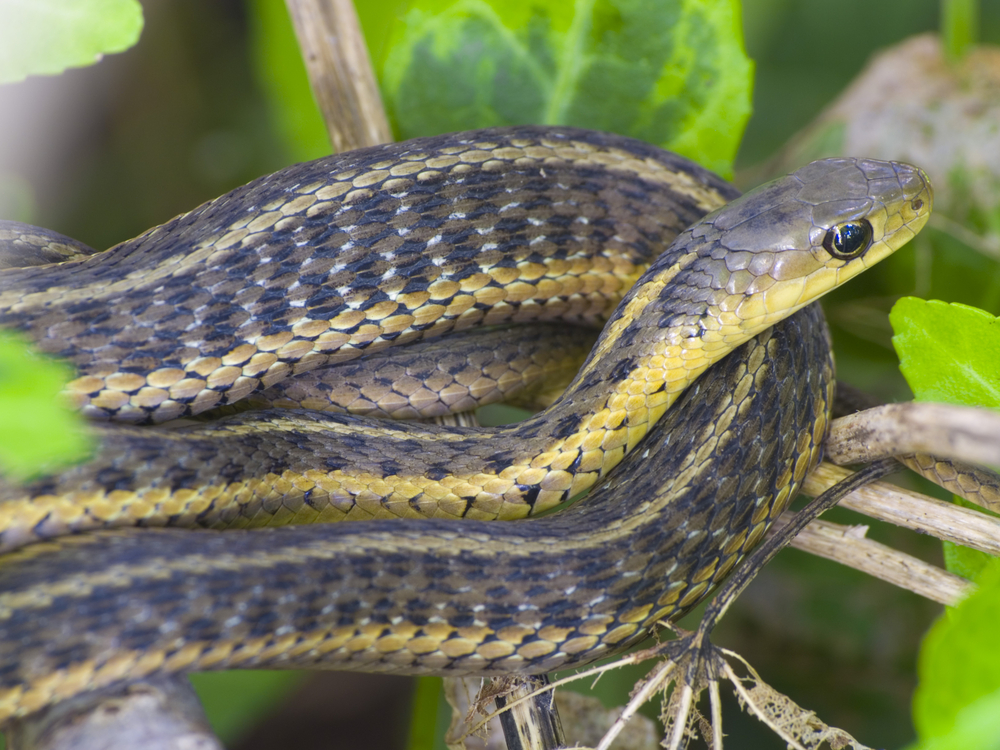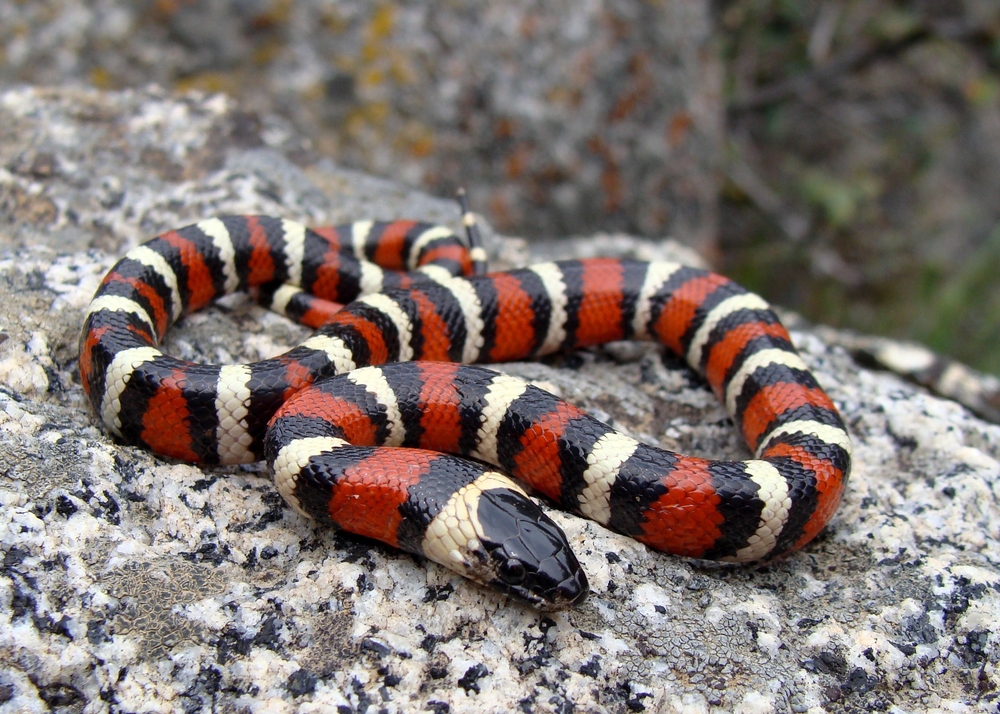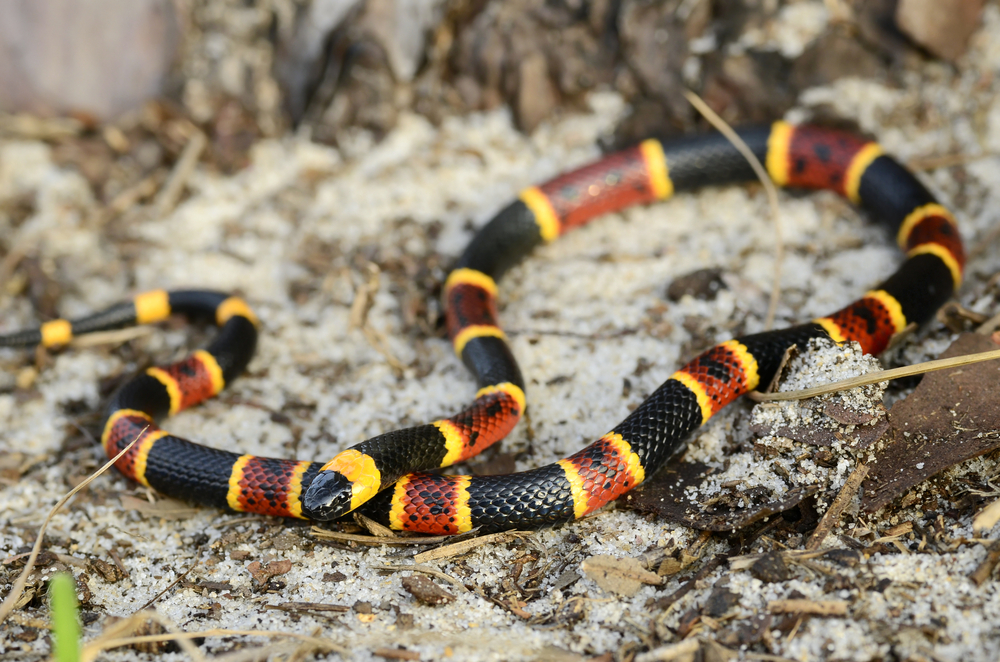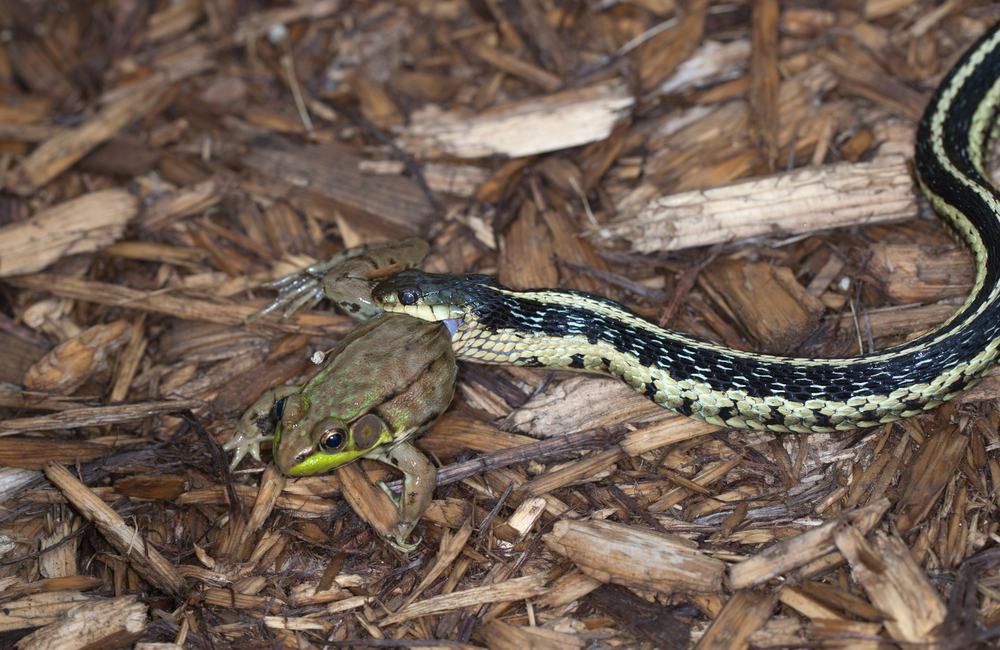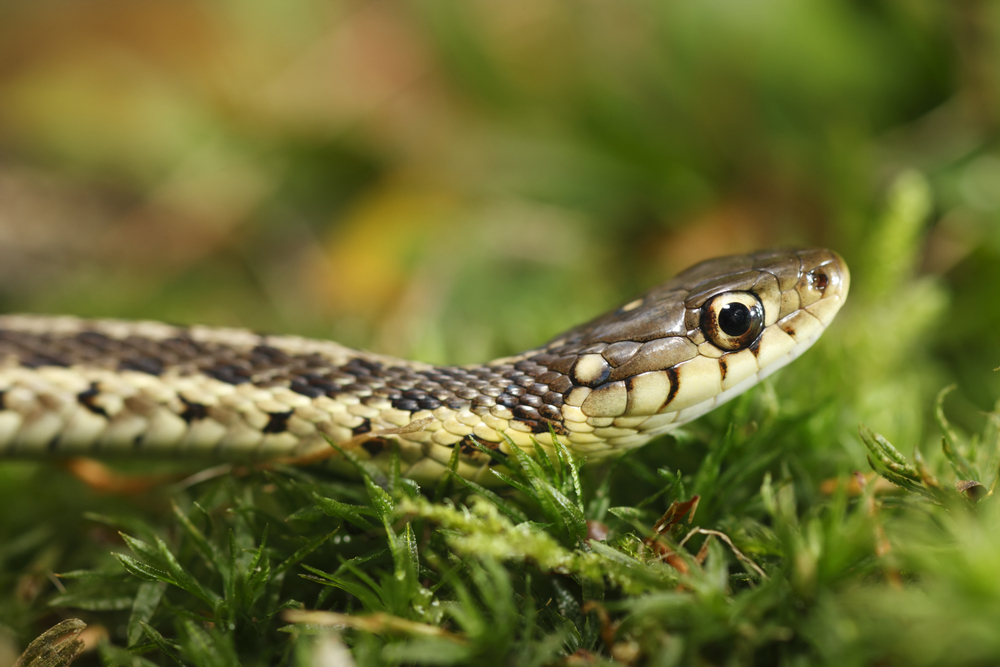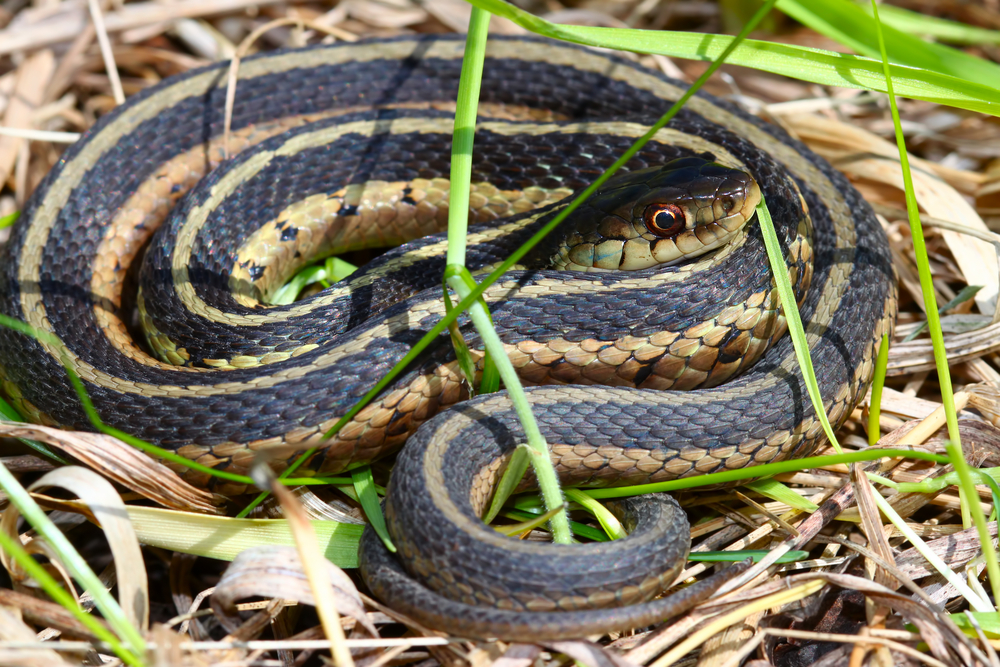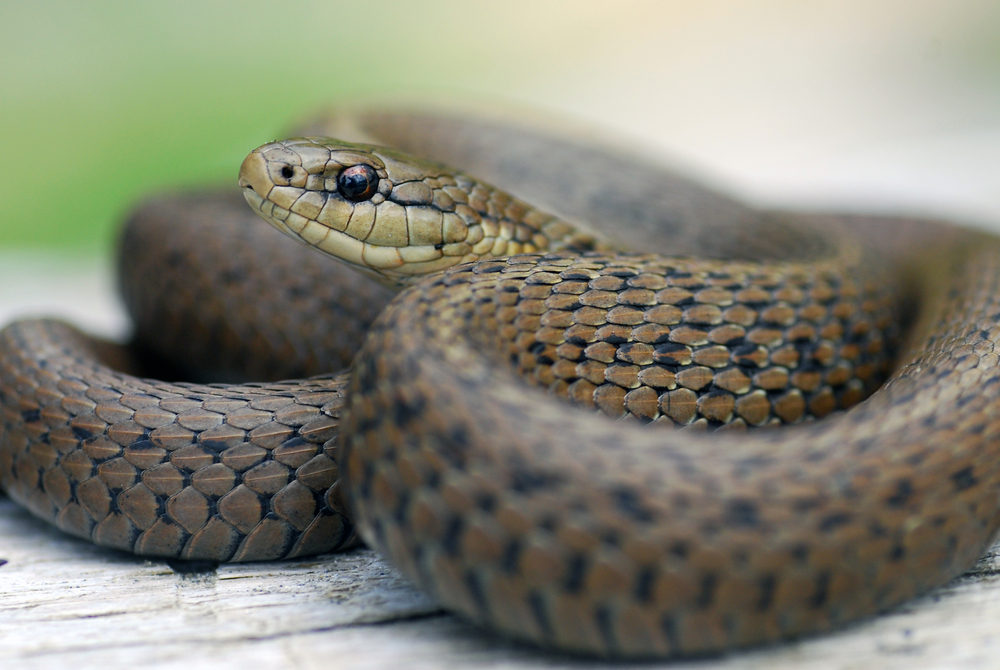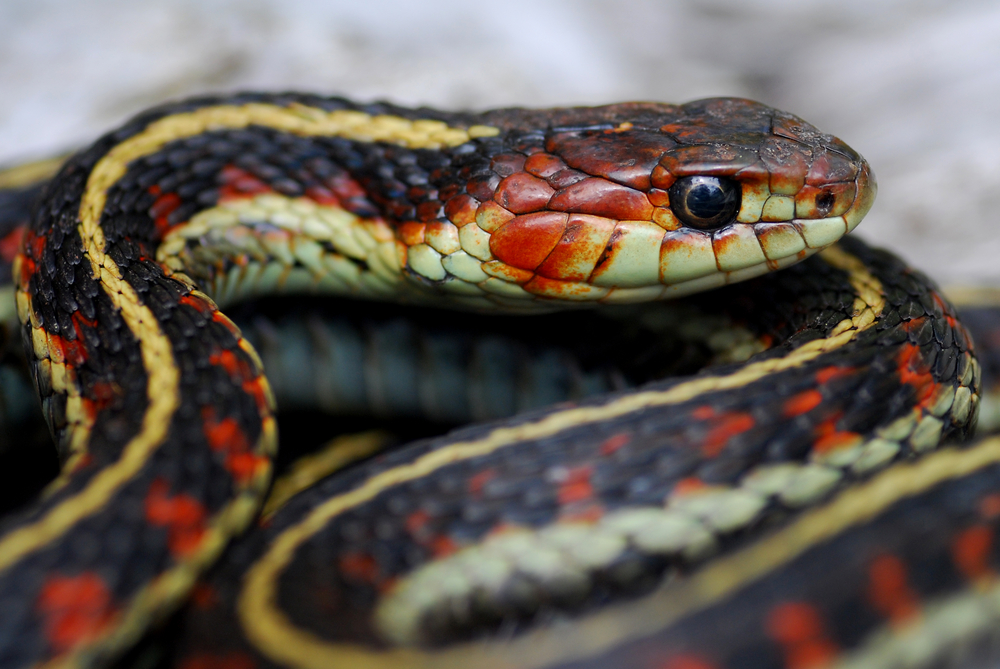About
The Garter Snake, belonging to the genus Thamnophis, is a widespread species found predominantly in North America. Recognized for their adaptability to a variety of habitats, Garter Snakes are a familiar sight in backyards, forests, fields, and near water bodies. As members of the Colubridae family, they are part of a group that includes many non-venomous or mildly venomous snake species.
Garter Snakes exhibit a range of color patterns, but most are identifiable by their long, slender bodies with stripes running lengthwise down their bodies. These stripes can be yellow, green, blue, or white, set against a background of varying shades of black, brown, or green. Their distinctive striping pattern is a key adaptation for camouflage and visual signaling.
In the Animal Kingdom, Garter Snakes fall under the class Reptilia and order Squamata, the same order that encompasses all snakes and lizards. Despite being one of the most common snake species in North America, they play a significant ecological role. As predators, they help control insect and rodent populations, contributing to the balance of ecosystems they inhabit.
Garter Snakes are known for their mild temperament and are often one of the first wild snakes encountered by people. This, along with their non-threatening nature, makes them an important ambassador for snake-human interactions, helping to dispel common misconceptions and fears about snakes.
Conservation Concerns
Garter snakes are not assessed for conservation status on the International Union for Conservation of Nature (IUCN) Red List as a species. However, certain subspecies or populations may face localized threats from habitat loss, degradation, and fragmentation due to urbanization, agriculture, and infrastructure development.
Additionally, Garter snakes may be targeted by humans for persecution or collection for the pet trade, although the impact of these activities on wild populations varies depending on local regulations and enforcement.
Physical Characteristics
The Garter Snake is a visually distinctive species with notable physical characteristics:
Physical Appearance:
Body: Garter Snakes have a slender, elongated body typical of many non-venomous snakes. They are agile and quick-moving.
Skin Color and Pattern: One of their most recognizable features is the longitudinal stripes that run the length of their body. These stripes are usually yellow, green, blue, or white, contrasting against a darker background color that can be black, brown, or green.
Head: The head is slightly wider than the neck but not as pronounced as in some other snake species. They have round pupils and a relatively gentle facial appearance.
Size and Weight:
Length: The size of Garter Snakes can vary significantly depending on the species. On average, they range from 18 inches to 4 feet (45 cm to 1.2 meters) in length.
Weight: They are relatively lightweight due to their slender build, usually weighing between 5 ounces to slightly over 1 pound (140 grams to 500 grams), with this varying according to age, sex, and overall health.
The Garter Snake’s physical form, with its distinctive striping and agile body, enables it to thrive in various environments. Their appearance is not just for camouflage; the stripes also play a role in deterring predators and aiding in thermoregulation. Despite their commonness, Garter Snakes are an important part of the ecosystems they inhabit, serving as both predators and prey.
Reproduction
The Garter Snake’s reproductive cycle is characterized by unique features that distinguish it from many other snake species:
Mating:
Garter Snakes usually mate in the spring, shortly after emerging from hibernation. In some regions, large congregations of snakes can be observed during this period, where multiple males gather around a single female, leading to a mating ball.
Gestation:
The gestation period in Garter Snakes varies depending on environmental factors like temperature and availability of food, but it generally lasts around two to three months.
Birth:
Garter Snakes are ovoviviparous, meaning they give birth to live young instead of laying eggs. The embryos develop inside the female’s body, and she gives birth to fully formed, independent offspring.
The number of young per litter can vary widely depending on the species and the size of the female. A typical litter can range from 10 to 40 young, but in some cases, larger females can give birth to over 80 babies.
Post-Birth Care:
Garter Snake newborns are independent from birth and receive no parental care. They are born with the ability to hunt and fend for themselves, feeding on small invertebrates like worms and amphibians.
The reproductive cycle of the Garter Snake, particularly its live birth and the large number of independent young it produces, is a fascinating aspect of its biology. This reproductive strategy is advantageous in many of the environments Garter Snakes inhabit, ensuring a high survival rate for the offspring.
Lifespan
The Garter Snake has a considerable lifespan, both in the wild and in captivity:
Lifespan in the Wild:
In their natural habitat, Garter Snakes typically have a lifespan of around 4 to 5 years, although some can live longer, up to 10 years. The variation in lifespan can be attributed to environmental factors, predation, and availability of food.
Lifespan in Captivity:
In captivity, where they are safe from predators and have consistent access to food and care, Garter Snakes can live significantly longer. It’s not uncommon for them to reach 6 to 10 years of age, and some may live up to 12 years or more in zoological settings or as pets.
Major Threats:
- Predation: In the wild, Garter Snakes face predation from various animals, including birds of prey, larger snakes, and mammals like raccoons and foxes.
- Habitat Loss: Urban development, agriculture, and pollution can lead to loss of habitat and food sources for Garter Snakes.
- Human Interaction: They can be inadvertently harmed by human activities, such as lawn mowing, vehicle traffic, and unintentional encounters with people.
- Disease: Garter Snakes are susceptible to various diseases, particularly in wild populations under stress from environmental changes.
Despite these threats, Garter Snakes are generally resilient and adaptable, capable of thriving in a variety of environments. They are often among the most common snake species in their geographic range. Conservation efforts, habitat protection, and public education are essential for ensuring their continued survival and the health of the ecosystems they inhabit.
Eating Habits
The Garter Snake exhibits versatile and opportunistic eating habits:
Diet:
Variety in Prey: Garter Snakes have a diverse diet, feeding on a range of prey including earthworms, slugs, amphibians (like frogs and toads), fish, small mammals (such as mice), and sometimes insects. Their diet can vary depending on their habitat and the availability of prey.
Hunting Techniques:
Active Foraging: Garter Snakes are active hunters. They typically forage for prey in areas of dense vegetation, near water, or in other places where their prey is likely to be found.
Chemical Sensing: They use their forked tongues to pick up chemical cues from the environment, helping them locate and track prey.
Constriction: While Garter Snakes are not powerful constrictors like some other snake species, they may use a form of mild constriction or simply grab and swallow their prey directly, particularly when feeding on amphibians and fish.
Feeding Behavior:
Swallowing Whole: Like most snakes, Garter Snakes swallow their prey whole. They have flexible jaws that enable them to consume prey larger than their head diameter.
Adaptability:
Garter Snakes are highly adaptable in their diet, which allows them to thrive in a wide range of environments. This adaptability is key to their survival and success as a species.
The Garter Snake’s feeding habits underscore its role as an important predator in its ecosystem. Their diet and hunting methods contribute to controlling the populations of various small animals and insects, thereby maintaining ecological balance in the areas they inhabit.
Uniqueness
The Garter Snake is unique in several ways that distinguish it within the reptile world:
Widespread Distribution and Adaptability: Garter Snakes are one of the most widespread snake species in North America, found from Canada to Central America. They thrive in a variety of habitats, including forests, fields, wetlands, and urban areas, showcasing remarkable adaptability.
Diverse Diet: Their diet is more varied than many other snake species, including earthworms, amphibians, fish, small mammals, and sometimes insects. This opportunistic feeding behavior allows them to adapt to different environments.
Mildly Venomous: Garter Snakes are one of the few snake species that are mildly venomous. However, their venom is not harmful to humans and is primarily used to subdue small prey.
Birth Method: They are ovoviviparous, giving birth to live young rather than laying eggs. This reproductive strategy is relatively uncommon among snakes and gives their young an advantage in survival from the start.
Social Behavior: Garter Snakes are known for their sometimes-social behavior, particularly during hibernation when they gather in large numbers in communal dens.
Chemical Communication: They use pheromones for communication, especially during the mating season. This chemical communication is crucial for their social interactions.
Human Interaction: Garter Snakes are often one of the first wild snake species encountered by people, particularly in North America. Their general harmlessness and common presence near human habitations make them an important species for public education about wildlife.
These characteristics make the Garter Snake a unique and important species ecologically and culturally. Their presence in diverse habitats and their role in controlling pest populations highlight their ecological importance.
Related Family Species
Sources
- Britannica, Garter Snake, https://www.britannica.com/animal/garter-snake, retrieved January 2024.
- Burnie, David & Wilson, Don, Animal, Smithsonian Institute, Washington DC.
- Hickman et al, Integrated Principle of Zoology, McGraw Hill, Boston.






























































